If recent eBay ads are any indication, Montana is teeming with clean, usable farm trucks that are patiently waiting for a new owner to put them to work. This 1956 International is simply the latest to grab my attention. Originally Cascade Green over Adirondack Green (according to the seller), it now wears a mixture of paint, primer, and hard-earned rust after almost 70 years under the bleaching sun. From the looks of it, there’s nothing this truck can’t do.
It’s one of those stories that’s difficult to prove, but I once read that many farmers bought International trucks because they could be serviced at the same dealer that serviced their Farmall tractors. Or perhaps the International dealer was the only dealer in town. Regardless, one gets the idea that guys who knew hard work bought Internationals, and that they were serious machines.
International’s specification sheets (thank you, Wisconsin Historical Society) labeled the cab as the “Comfo-Vision” cab, which is as good a descriptor as I’ve heard all day. Features are sparse, as one would expect, but this one has a working heater and windshield wipers that need a little nudge to get going. Unfortunately, the turn signals and fuel gauge will need some help.
Under the hood is the “Black Diamond” 240 cubic-inch six, which produced a good-for-the-time 131 horsepower and 208.5 lb.-ft. of torque. When teamed with a 4.55:1 gear, you can probably climb a wall, slowly. The owner warns potential buyers that this is not the kind of truck you fly in and drive home – it’s slow and not suited to modern high-speed thoroughfares. On the other hand, if you have some vacation time to spend, maybe a leisurely trip through the back roads of the Big Sky state would be a relaxing diversion from the non-ranch lifestyle.
The seller says that the engine runs well and doesn’t smoke, but they do notice a little engine noise when cold that might be piston slap (it goes away as the engine warms up). The four-wheel-drive system works in both ranges.
Another selling point is the International’s solid Montana body. Binders were at least as susceptible to rust as anything else, so anyone looking at these door bottoms and sills understands how solid this truck is.
Old trucks have been popular for quite a while now, as many of you know from regularly visiting barnfinds.com. This S-120 should therefore bring a fair price, but how much? It’s currently on eBay with a high bid of $3900 with five days left to go on the auction. Thanks to PeteMcgee for finding this cool old International work truck.
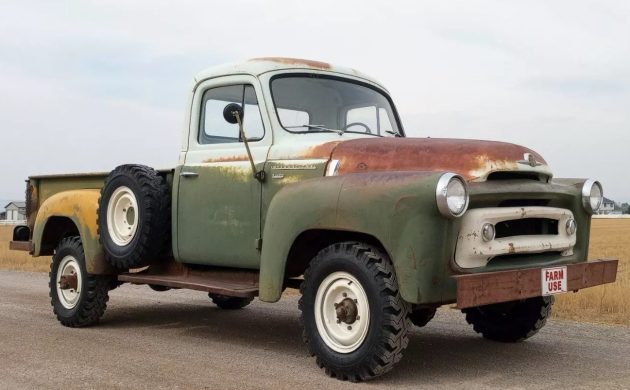
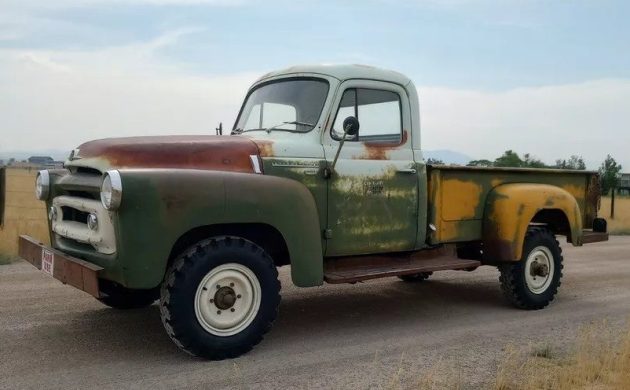

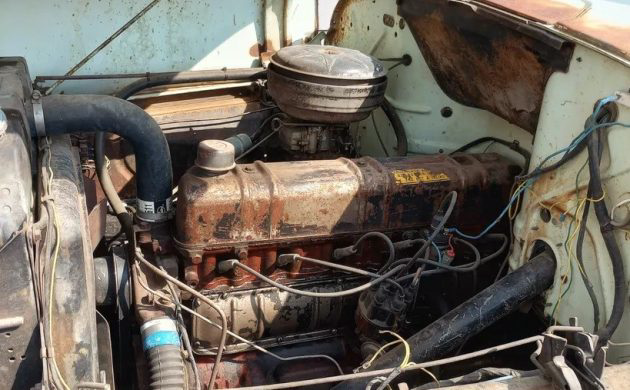
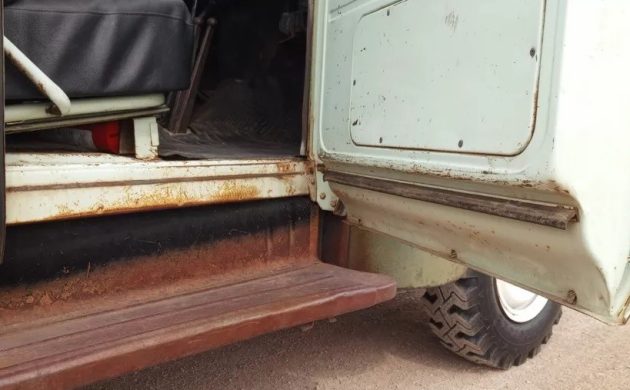
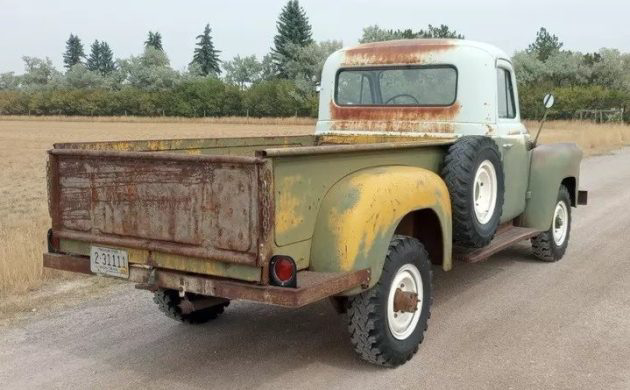


GREAT old truck-this has more levers the inside of a new Catapillar excavator! No frills (except for the heater-the radio’s probably been missing for a few years), now 1000 ft# of torque but more than enough for most jobs around the rancherito.
This has got some real character-fix any safety stuff and drive it as is for awhile before making it look new again.
Hi Nev, the heater was an add on option, maybe $50 bucks extra, radios were non-existent, considered a distraction. This truck cost just over $1500 new, 4×4 added a hefty $600 bucks, but was well worth it. That was a lot of money for a farm, as they, for the longest time, had the rank of the poorest paid job in the US. In the 50s, a farmhand made just over $30/month, ( but no other bills) so frugality was the rule.
I can hear keyboards clacking away in the distance. This truck is red meat for some of the viewers of BF. I (seriously) can’t wait to hear the reminiscences generated by this vintage truck. Nice find.
Howard I don’t feel like typing,go for it and I’ll give you a thumb up
:)
Okay, briefly, the S series was a 1 year wonder, in between the ’53 -’55 R series and the ’57 A series, also a 1 year wonder. The S series, not to be confused with the larger S series, was pretty much the same mechanically as the R series, just had new front fenders and grill. The “Comfo-vision” cab mentioned, was introduced in 1949 for the L series, made by a firm in Chicago, you want to talk about job security, that outfit produced MILLIONS of cabs probably into the ’70s. Not only did IH use that cab, but several companies used them as well. The motor, while getting on in years, was used, with its sibling, the Silver Diamond 220, from 1949-1969, and were the staple of IH pickups for years. Fact is, IH never produced any other in line 6, and used AMC 6 cylinder motors in 1969 I believe until the end with the Scout in 1980. Again, the owner is honest, and while city traffic shouldn’t be an issue, anything over say 45, will seem like the world is coming apart( and it is) and simply not designed for anything except what it is. A wonderful find, and a much more plausible price. I love everything about these trucks, from the “outta my way” 5 mph steel beam front bumper, to the basic design and function. No info boards here. Running boards, but no info boards. Now, if you’ve never driven one of these, you will be in for a rude awakening. “You drove these death traps, gramps” “That’s right, and guess what, we didn’t die driving one”.
I guess that wasn’t considered brief, but I do love old trucks, Thanks, Rw, no need for the thumbs up, if it works.
A little bit of confusing clarification, Bro: The S-series filled 1956 and into ‘57. It was a mixed bag with 6V electrics morphing into 12V. The SD engine became the B/BD which was unchanged except for painting it black. Then came the “Tilt Valve” which was exactly what they said it was. Immediately recognizable by the wider valve cover. Still using the B/BD moniker. In the small sixes the ‘B’ was Canadian-built and the ‘BD’ was American. Otherwise the same.
To add to the confusion, people referred to these as the ‘Black Diamond.’ A lot of discussion over this. People argued that the real Black Diamond was the 269 thru 308, built from ‘52 to ‘74. It was morphed from the ‘Blue Diamond’ 250 – 269 which began life in 1940 (from the FA/FB). Immediately recognized by the long distributor shaft which perched the distributor up beside the valve cover.
Now the fun really begins. In ‘60 the B/BD became the BD/BG. The BD (240/264) was black and was Canadian-built. The BG (241/265) was a moldy green and was American-built. I was told that the only difference between the two (other than the color) was the thickness of the top ring.
I’ve had them all apart and never noticed the difference.
By ‘67 IH decided to call them all BD and then started painting them Harvester Red, like the V8s. They were all 264 CID as well. Federal emissions sacked it in American light trucks in 1970 but it lasted a couple years longer in Canada, but would continue in the Loadstar on both sides until ‘75.
Then it was the handy AMC…
HA! No sense in arguing with the master, I’d like to think I get the conversation started, and you finish it off correctly. For the record, I bet very few even know what you are talking about. When mentioning IH pickups today, you may as well said the Hindenburg, as folks today have about as much experience with one.
Well, Howard, by the time I finish writing down everything that’s on my mind, I wonder if I REALLY know what I’m talking about. Working on this stuff for most of my life, I sometimes get to thinking that I know a few things. Next thing I know, some sidewalk commando will speak up and hand my backside to me. I’m fairly well schooled on a lot of trucks and power units but I’m far from being an authority. Some call me an “expert.” And that’s OK as long as ‘ex’ means ‘Has-Been,’ and ‘spurt’ means ‘Drip Under Pressure.’
While I usually dont like patina , real or faked , it works with this truck. I’d fix what needs to be fixed and enjoy it
What a beautiful old truck. Luv it!
“What they said” Great truck. I’m off to Montana next week. Over the years, no matter how fast I drive on Montana highways I am always passed by some well worn old “goin’ to town” pick up.
I love it!! That fine old machine left the factory floor back when a truck was a truck. The manufacturers knew what a truck was and the red-blooded working guys who bought trucks knew what a truck was.
Not like today, when a “pickup truck” has become a ninety-thousand dollar, four-door, short bed, electronics riddled marshmallow barge that appears to be intended to cruise the boulevard and try to pick up women of compromised virtue.
Both of my Grand fathers drove IH pickups and my uncle continued to drive 1 of them ( 1955 short box step side 6 cyl 3 on the tree ) as a DD into the 70’s. I’m a life long truck mechanic and have always thought that one day I would drive an old pickup as a fun vehicle, but they have passed my pay grade and good for them, I do not begrudge these people their hard earned money, my oldest warned me this was coming 15 years ago and I did nothing. This is a beautiful truck and will bring the next owner great pleasure, get her on the road and do a little something every spring or fall and before you know it’s finished after driving it the entire time. Good luck to the buyer. By the way when a vehicle lasts 68 years compared to 10 years it reduces it’s carbon foot print significantly.
I had one ASW 120 1957 It was bought new by the Department of Lands here in Australia . Rear in Australia . I went away in it on our Honeymoon to the Outback . They are built tough and rugged . I was told that the W stood for 4wd .
The first S-Series trucks definitely were a stepping stone between the R and the A-Series. The cabs had some minor changes through the years. Originally the ’50 and early ’51 models had hidden door hinges. In ’55 the door latches were changed to push-button and the side windows grew by an inch and a half. The most noticeable difference was the single rear to replace the dual windows. The cab didn’t change much after that with the exception that the V-Series HD trucks used (2) cowl vents.
As you said, the cab was used for many years by (actually 19) many different manufacturers. It was one of the biggest windfalls that IH ever had.
This was the first year that Binder offered 4×4 in anything smaller than the 140 series. My Dad bought one back in the day but he got rid of it after 3 years because it was in the shop more than it was in use. But when he traded the S-120 for the A-120 2WD he found it was in the shop just as often. He eventually found the root of the problem in the form of the ranch foreman who could destroy anything that wasn’t covered with hair. He had no concept of driving a truck across the prairie.
The S-120 got sold to a rancher out by the Sweetgrass Hills. That truck saw daily use since then and is still used today. I sure wouldn’t mind seeing this truck or Dad’s old one at my place…
Sweet….happy trails to the new owner !